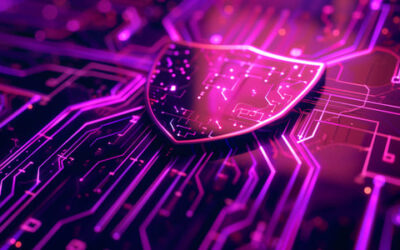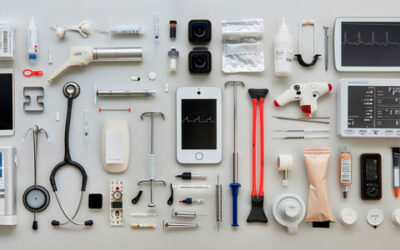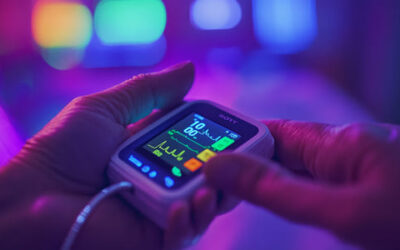[dsm_gradient_text gradient_text="The Road to ISO 27001 Certification: A Step-by-Step Guide" _builder_version="4.27.0" _module_preset="default" header_font="Questrial|||on|||||" header_text_align="center" header_letter_spacing="5px" filter_hue_rotate="100deg"...
Organic Thermoelectrics: Turning Heat into Power with the Materials of the Future!
Imagine if you could charge your phone just by wearing your hoodie, or if your laptop could recycle its own heat to power itself. Sounds futuristic, right? Well, organic thermoelectrics are making this a reality! This cool (or should we say hot? 😏) technology is all about using special materials to turn wasted heat into usable electricity.

If you’ve never heard of thermoelectrics, don’t worry! We’re about to break it down in the simplest way possible. Whether you’re into sustainable energy, cutting-edge materials, or just love geeking out over new tech, you’ll want to keep reading!
What the Heck Are Thermoelectrics?
Before we dive into organic thermoelectrics, let’s first talk about the basic science behind them.
Thermoelectric materials can convert heat into electricity using a concept called the Seebeck effect. Here’s how it works:
- When one side of the material gets hot and the other stays cool, electrons start moving from the hot side to the cool side.
- This creates an electric current – just like a battery!
- That electricity can then be used to power devices or store energy.
There’s also the Peltier effect, which works in reverse: if you apply electricity, it can create a temperature difference, which is how thermoelectric coolers (like mini fridges) work!
Why Should You Care?
(Spoiler: It’s a Game-Changer for the Future)
🌱 Eco-Friendly Energy – Instead of wasting heat from factories, cars, or even your body, we can recycle it into power!
🔋 Better Battery Life – Future wearables could charge themselves using body heat.
💻 Cooler Gadgets – Thermoelectrics could prevent laptops, gaming consoles, and phones from overheating while making them more energy-efficient.
🚗 Smarter Cars – Vehicles could reuse engine heat to power electronics, reducing fuel consumption.
Sounds amazing, right? But here’s the thing—most traditional thermoelectric materials are made from expensive, rigid, and sometimes toxic inorganic materials like bismuth telluride. This is where organic thermoelectrics come in and totally change the game.
Meet Organic Thermoelectrics: The Coolest (and Hottest) New Materials!
Organic thermoelectric materials are carbon-based (yep, like plastic and other organic compounds), and they come with some HUGE advantages over traditional materials:
✨ Flexible & Lightweight – Imagine thermoelectric stickers, fabrics, or tattoos that can generate power from your body heat!
💰 Cheaper & More Sustainable – These materials are made from abundant elements instead of rare, expensive metals.
🧪 Easier to Customize – Scientists can tweak their structure to make them even better at conducting electricity and keeping heat in check.
How Do These Materials Actually Work?
Organic thermoelectrics work similarly to their inorganic counterparts, but with a twist:
- Instead of rigid crystals, they use soft, flexible polymers (aka, long chains of repeating molecules).
- These materials conduct electricity but don’t conduct heat as much, which is exactly what we need for good thermoelectric performance.
- Scientists can improve them by adding dopants—extra molecules that tweak how easily electrons move through the material.
%
Market Growth
The global thermoelectric materials market was valued at approximately USD 4.2 billion in 2023 and is projected to reach around USD 9.8 billion by 2032, growing at a robust CAGR of 9.7% during the forecast period. Source: DataIntelo Thermoelectric Material Market Research Report 2032
%
Thermoelectric Efficiency
A record-high thermoelectric efficiency of 16% has been achieved by combining computer-aided design for geometry optimization with an increased figure of merit. Source: RSC Advances Recent trends and future perspectives of thermoelectric materials and their applications
The Science of Making Them More Powerful
Okay, so organic thermoelectrics sound cool, but how do we make them actually work well?
Researchers have been testing three main tricks to improve their efficiency:
🔬 Tweaking the Molecular Structure
- Scientists modify the chemical structure of polymers to boost electrical conductivity while keeping heat flow low.
- Example: By adding special side chains to molecules, they can improve how neatly they stack together, making it easier for electrons to flow.
🔋 Smart Doping
- Just like adding salt to fries enhances the taste, adding the right dopants makes thermoelectric materials conduct electricity better!
- The trick is to boost charge carriers (the moving particles that create electricity) without messing up the material’s stability.
📏 Nanoscale Engineering
- Scientists are experimenting with nanoparticles and ultra-thin layers to boost efficiency.
- Making materials at the nanometer scale helps keep the good properties (high conductivity) while reducing the bad ones (heat loss).
Challenges
AKA: Why Aren’t These Everywhere Yet? 😬
As awesome as organic thermoelectrics sound, there are still some roadblocks:
⏳ Durability Issues – Some organic materials degrade over time, especially when exposed to moisture and air.
🌡️ Balancing Act – Boosting electrical conductivity often increases heat conductivity, which isn’t great for efficiency.
🏭 Scaling Up – Producing these materials at an industrial scale cheaply and reliably is still a work in progress.
Despite these challenges, researchers are making big progress, and it’s only a matter of time before we see real-world applications!
Real-Life Uses: Where Can We Expect to See These?
👕 Self-Charging Wearables – Clothes that generate power from body heat, so you never have to charge your smartwatch again!
🏠 Smart Homes – Windows and walls that harvest heat to power smart devices.
♻️ Waste Heat Recycling – Factories, cars, and even our own electronics could convert waste heat into electricity, reducing energy waste.
🛸 Space Tech – In extreme environments (like outer space), these materials could help power rovers, satellites, and space suits.
The Future of Organic Thermoelectrics: What’s Next?
We’re still in the early days of organic thermoelectrics, but things are moving fast. Scientists are working on:
🔬 New Materials – Discovering even better organic compounds for improved performance.
💡 Better Manufacturing – Finding cost-effective ways to mass-produce flexible thermoelectric devices.
🔋 Integrating with Tech – Exploring how to add these materials to batteries, solar panels, and everyday electronics.
Conclusion
Organic thermoelectric materials represent a vibrant and evolving field, bridging the gap between materials science, chemistry, and engineering. While challenges remain, the potential applications in sustainable energy and flexible electronics make this an exciting area of research. Continued interdisciplinary collaboration and innovation are key to unlocking the full potential of organic thermoelectrics.
References
- Aitchison, C. M., Awaga, K., Data, P., Fujigaya, T., Fujino, T., Fukazawa, A., Guo, X., Heeney, M., Ie, Y., Nakagawa, S., Nakamura, M., Nakatsuka, N., Nishide, H., Schroeder, B. C., Skabara, P., Singh, M., Tani, Y., Tanaka, Y., Tsuchiya, Y., Uematsu, T., & Yakiyama, Y. (2024). Organic Thermoelectrics: General Discussion. Faraday Discussions, 250, 400-416. https://doi.org/10.1039/D4FD90009J
- Liu, Z., Haque, M. A., Savory, C. N., Rush, M., James, D. I., Dey, A., Chen, C., Bučar, D.-K., Clarke, T. M., Scanlon, D. O., & Schroeder, B. C. (2024). Controlling the Thermoelectric Properties of Organo-Metallic Coordination Polymers Through Backbone Geometry. Faraday Discussions, 250, 377-399. https://doi.org/10.1039/D3FD00139C
Wanna know more? Let's dive in!
ISO 27001 vs. Other Security Standards
[dsm_gradient_text gradient_text="ISO 27001 vs. Other Security Standards: Which One Is Right for You?" _builder_version="4.27.0" _module_preset="default" header_font="Questrial|||on|||||" header_text_align="center" header_letter_spacing="5px"...
Top Psychological Hazards Identified by ISO 45003—and How to Address Them
[dsm_gradient_text gradient_text="Top Psychological Hazards Identified by ISO 45003" _builder_version="4.27.0" _module_preset="default" header_font="Questrial|||on|||||" header_text_align="center" header_letter_spacing="5px" filter_hue_rotate="100deg"...
How to Implement ISO 45003: A Step-by-Step Guide
[dsm_gradient_text gradient_text="How to Implement ISO 45003: A Step-by-Step Guide" _builder_version="4.27.0" _module_preset="default" header_font="Questrial|||on|||||" header_text_align="center" header_letter_spacing="5px" filter_hue_rotate="100deg" hover_enabled="0"...
Common Pitfalls in Applying ISO 31000 And How to Avoid Them
[dsm_gradient_text gradient_text="Common Pitfalls in Applying ISO 31000 And How to Avoid Them" _builder_version="4.27.0" _module_preset="default" header_font="Questrial|||on|||||" header_text_align="center" header_letter_spacing="5px" filter_hue_rotate="100deg"...
How to Integrate ISO 31000 into Your Organization’s Culture
[dsm_gradient_text gradient_text="How to Integrate ISO 31000 into Your Organization’s Culture" _builder_version="4.27.0" _module_preset="default" header_font="Questrial|||on|||||" header_text_align="center" header_letter_spacing="5px" filter_hue_rotate="100deg"...
Top Benefits of Implementing ISO 31000 in Your Business
[dsm_gradient_text gradient_text="Top Benefits of Implementing ISO 31000 in Your Business" _builder_version="4.27.0" _module_preset="default" header_font="Questrial|||on|||||" header_text_align="center" header_letter_spacing="5px" filter_hue_rotate="100deg"...
ISO 31000 vs. ISO 27005: Differences and Similarities
[dsm_gradient_text gradient_text="ISO 31000 vs. ISO 27005: Differences and Similarities" _builder_version="4.27.0" _module_preset="default" header_font="Questrial|||on|||||" header_text_align="center" header_letter_spacing="5px" filter_hue_rotate="100deg"...
Ensuring Quality in Medical Devices: The Role of Process Validation and Revalidation
[dsm_gradient_text gradient_text="Ensuring Quality in Medical Devices: The Role of Process Validation and Revalidation" _builder_version="4.27.0" _module_preset="default" header_font="Questrial|||on|||||" header_text_align="center" header_letter_spacing="5px"...
AI in Medical Devices: Navigating the Regulatory and Ethical Minefield
[dsm_gradient_text gradient_text="AI in Medical Devices: Navigating the Regulatory and Ethical Minefield" _builder_version="4.27.0" _module_preset="default" header_font="Questrial|||on|||||" header_text_align="center" header_letter_spacing="5px"...
Understanding ISO 31000 vs ISO 14971: Similarities and Differences in Risk Management Standards
[dsm_gradient_text gradient_text="Understanding ISO 31000 vs ISO 14971: Similarities and Differences in Risk Management Standards" _builder_version="4.27.0" _module_preset="default" header_font="Questrial|||on|||||" header_text_align="center"...
Beyond FMEA: Rethinking Risk Management in the MedTech Industry
[dsm_gradient_text gradient_text="Beyond FMEA: Rethinking Risk Management in the MedTech Industry" _builder_version="4.27.0" _module_preset="default" header_font="Questrial|||on|||||" header_text_align="center" header_letter_spacing="5px" filter_hue_rotate="100deg"...












